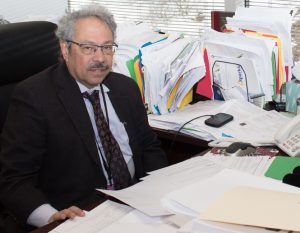Researchers alarmed by proposed NIH funding cuts in Trump budget
A proposed cut of nearly $6 billion to the National Institutes of Health in President Donald Trump’s budget outline could have serious consequences for scientific research in the country, according to researchers in Westchester.
Trump’s budget outline, released March 16, slashes $5.8 billion from NIH, about 18 percent of its budget. Trump’s budget director Mick Mulvaney described the proposal as a “hard power budget,” which includes plans for a $54 billion increase in defense spending while making majors cuts to the Environmental Protection Agency, State Department and Department of Housing and Urban Development among other agencies.
The proposal calls for a $15.1 billion reduction in the overall federal Department of Health and Human Services budget, which oversees the NIH. Health and Human Services Secretary Tom Price said in a statement that the sharply reduced budget will “ensure we are providing the highest level of service possible and not duplicating our efforts.”

But researchers in Westchester, as well as nationwide, say the cuts would deal a major blow to research in the country. The NIH budget was about $32 billion for fiscal year 2017 which ends on 30. A planned increase of $1 to $2 billion for FY 2017 did not materialize. The 21st Century Cures Act passed by Congress in December was supposed to add around $4.8 billion to NIH”™s budget, primarily for cancer research. Most of the NIH budget goes out in grants to researchers at universities, medical schools, and other research institutions. The federal organization is the largest public funder of biomedical research in the world.
Dr. Edward C. Halperin, chancellor and chief executive officer of New York Medical College, said the cuts represented a “catastrophic assault on biomedical science.”
“What does it mean if we cut research in medicine? It means people will die,” said Halperin. “Because they won’t have new therapies.”
About a quarter of the research at New York Medical College is funded through the NIH, according to Halperin. The Valhalla-based school receives about $37 million in research funding each year, about $9.7 million of which comes from the National Institutes of Health.
That funds research on the campus such as the work done by Dr. Michal Laniado Schwartzman, a professor and chair of pharmacology at New York Medical College. Schwartzman leads a four-person research team that studies the causes and treatment of hypertension, funded in part with NIH grants.
Schwartzman said she was concerned the cuts could hurt the country’s standing as the world’s leading funder of biomedical research.
“If we are not going to keep funding research at least at the level that we are funding today, we will lose the standing in the international community,” Schwartzman said.
New York received $2.2 billion in NIH funding in 2016, third among all states, according to an NIH database. The database breaks down awards by congressional district. The 17th district, which includes a large chunk of Westchester, brought in 62 grants worth about $26 million. Those include grants to New York Medical College, SUNY Purchase College and the Burke Medical Research Institute.
Dr. Rajiv R. Ratan, executive director of the Burke Medical Research Institute, said about $7.5 million in NIH grants helps cover research at the institute, which focuses mainly on repairing the brain and spinal chord from diseases, such as Alzheimer’s, and traumatic injuries, such as stroke.
About 100 researchers work at the 55,000-square-foot facility on Burke’s White Plains campus, which is academically separate from the rehabilitation hospital. The research center is affiliated with Weill Cornell Medicine.
Ratan said he was concerned the cuts could have a “devastating effect” on both Burke’s and the country’s ability to deliver cures for an aging population.
“By 2050, Alzheimer’s disease and stroke alone will cost the United States $1.4 trillion, which is about 10 percent of our GDP,” Ratan said. “So the idea that at a time when you have this epidemic looming, to actually reduce investment in research that could not only reduce that cost, but more important reduce suffering for the individuals and their families, it’s hard to understand.”
Ratan also said that cuts could send young research talent away from the medical field, as grant funding dries up. That was a concern echoed by Dr. Salomon Amar, provost for biomedical research at the Touro College and University System, which includes New York Medical College and Touro College of Dental Medicine in Hawthorne.
“Large labs will downsize and people that may not be able to be successful in obtaining grants will leave the science field,” Amar said. “And we’re going to lose science in the long run.”
Trump’s budget outline said the plan will include a reorganization of the NIH’s institutes and centers to “help focus resources on the highest priority research and training activities.” His administration has promised more details in its full budget proposal in May.
But the final say on any cuts goes to Congress, where the NIH has traditionally received bipartisan support. Rep. Paul Ryan, the Republican Speaker of the House, said in an interview with Fox News that there will likely be changes to NIH cuts. He noted that Congress had recently passed the 21st Century Cures Act, which allocated additional funding to the NIH.
Dr. Mitchell A. Cairo is director of the Children and Adolescent Cancer and Blood Diseases Center at New York Medical College, where a 15 to 20-person research team utilizes NIH funding to search for more effective cancer and blood disorder treatments.
Cairo said he can understand a desire to cut into the federal deficit, but he said biomedical research funding is an area that deserves protecting.
“Because it gives back so much more than the dollars that are being provided,” Cairo said. “If we understand disease better and improve outcomes and keep people healthy, that means if you invest a dollar, you get $10 more because you cut health care costs, you keep people at work and keep people happier.”